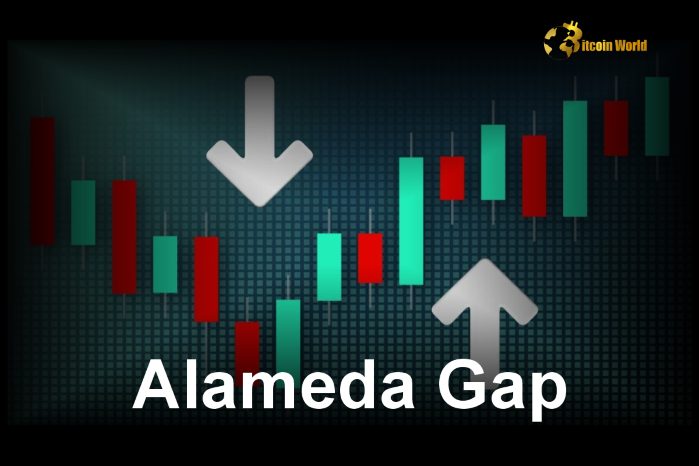The Alameda Gap: Crypto Liquidity Normalizes After Two Years of Volatility
Two years after the collapse of Alameda Research, the liquidity gap in the cryptocurrency market, referred to as the “Alameda gap,” has officially closed, according to Kaiko, a leading crypto market data and analytics firm. This marks a significant milestone for the crypto industry, demonstrating resilience and recovery after one of its most tumultuous periods.
Kaiko revealed this recovery on X (formerly Twitter), highlighting that U.S.-based exchanges, including Coinbase, played a pivotal role in closing the liquidity gap. The firm cited the Bitcoin 1% Depth on U.S. Exchanges indicator as a measure of this achievement.

What Was the Alameda Gap?
The “Alameda gap” refers to the liquidity void that emerged following the collapse of Alameda Research, the trading arm and sister company of bankrupt crypto exchange FTX.
- Liquidity Impact: Alameda’s downfall left a significant hole in the market, particularly on U.S. exchanges, where its trading activity had provided substantial liquidity.
- Ripple Effects: The gap disrupted price stability, widened spreads, and reduced depth across order books, creating a challenging environment for traders and investors.
Alameda’s collapse was one of the most high-profile failures in crypto history, exposing vulnerabilities in centralized exchanges and trading firms.
Kaiko’s Analysis: Signs of Recovery
Kaiko’s data-driven analysis shows that the U.S. crypto market has now returned to pre-collapse liquidity levels.
- Bitcoin 1% Depth: This metric measures the amount of buy and sell orders within 1% of Bitcoin’s mid-price. Improvements in this indicator reflect restored liquidity and reduced volatility on exchanges.
- Role of U.S. Exchanges: Platforms like Coinbase have bolstered market depth by attracting institutional and retail traders, mitigating the void left by Alameda.
The recovery suggests that the market has adapted to the absence of Alameda’s trading activity, relying on diversified sources of liquidity.
Factors Driving the Liquidity Recovery
Several factors contributed to closing the Alameda gap, including:
1. Increased Institutional Participation
- Institutional Inflows: The entry of institutional players like BlackRock and Fidelity into crypto markets provided much-needed liquidity.
- ETF Approvals: Bitcoin and Ethereum ETFs have drawn attention and funds, enhancing market depth.
2. Exchange Adaptability
- Order Book Strategies: U.S. exchanges implemented measures to stabilize order books, such as incentivizing market makers and reducing trading fees.
- Focus on Regulation: Exchanges like Coinbase leaned into compliance, attracting traders seeking safer platforms post-FTX.
3. Broader Market Resilience
- Bitcoin Price Rally: The current bull market in Bitcoin and Ethereum has invigorated trading activity and liquidity.
- Decentralized Alternatives: Growth in decentralized finance (DeFi) has supplemented traditional liquidity sources, easing pressure on centralized platforms.
Impact on the Crypto Market
The closure of the Alameda gap signifies more than just a return to normalcy—it reflects the maturing resilience of the crypto market.
- Improved Stability: Restored liquidity enhances price stability, reducing the likelihood of extreme volatility during high-volume trades.
- Investor Confidence: The recovery bolsters confidence among traders and institutions, encouraging further market participation.
- Global Implications: While the recovery was focused on U.S. exchanges, the global crypto ecosystem benefits from improved liquidity across major markets.
What Lies Ahead for Crypto Liquidity?
With the Alameda gap now closed, the focus shifts to sustaining and enhancing market liquidity. Key areas of attention include:
1. Regulatory Clarity
Clear and consistent regulations will help attract more institutional participants, ensuring robust liquidity across exchanges.
2. Exchange Competition
Exchanges must continue innovating to retain and attract traders, leveraging tools like advanced trading features, improved user experiences, and competitive fees.
3. Role of Decentralized Finance
DeFi platforms could emerge as complementary liquidity providers, further reducing reliance on centralized entities.
Conclusion: A Resilient Recovery for Crypto Markets
The closing of the “Alameda gap” marks a pivotal recovery for the cryptocurrency industry. Two years after the collapse of Alameda Research, U.S. exchanges have successfully restored liquidity levels, demonstrating the sector’s ability to adapt and thrive amid challenges.
As the market continues to evolve, the lessons from Alameda’s collapse will likely shape future strategies for mitigating risks and building a more resilient trading ecosystem.
To learn more about the innovative startups shaping the future of the crypto industry, explore our article on latest news, where we delve into the most promising ventures and their potential to disrupt traditional industries.
Disclaimer: The information provided is not trading advice, Bitcoinworld.co.in holds no liability for any investments made based on the information provided on this page. We strongly recommend independent research and/or consultation with a qualified professional before making any investment decisions.


